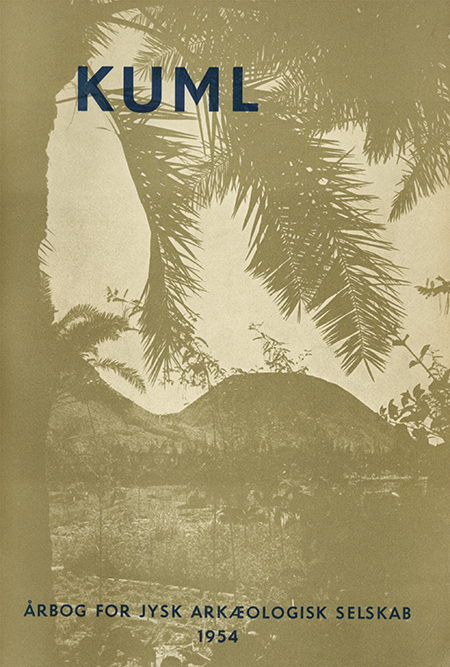En trehovedet Gud
DOI:
https://doi.org/10.7146/kuml.v4i4.97145Keywords:
Three-faced God, tre hovedet gudAbstract
A Three-Headed God
In a garden belonging to a farm in Glejbjerg in Southern Jutland a stone head with three faces has hitherto stood unheeded. It rests on a large triangular stone on which is also seen a face in relief. The stone head was found about 1880 by children playing in a gravel pit near the farm, in which other stones were found and were used for erecting two buildings on the farm. The stone head and the triangular stone were first built together into a wall of one of these buildings, but later, when it was rebuilt in 1906, the two were moved out into the garden (fig. 1). The stone sculptures were regarded with superstition on account of their peculiar and mystical appearance. The head is cut out of fine-grained granite and has a diameter of about 11". Two of the faces are carefully fashioned, the third one is only sketched (figs. 2 and 3). The hair seems to be indicated and shows some traces of an ornament (fig. 4). There is no flat surface on the top of the head which could suggest that the head had been used as a bearing element in a building, nor is there any hole in the bottom for mounting. On the forehead of one of the faces is seen a peculiar triangular figure with a knob, while on the forehead of the next there is a triangle without the knob. This face is furthermore surrounded by a sort of cord. Until recently a well lay near the place where the head was found.
A similar three-faced head stood until recently on a Romanesque stone pillar in the garden of the estate of Bramminge, some 10 miles to the southwest of Glejbjerg. It has now been moved into the main building. This head is a little larger than the Glejbjerg head, and the noses of two of the faces are damaged (figs. 9, 10 and 11). The same triangular ornaments and the same cords are seen on this head, the triangle with the knob, however, being much more accentuated. A cord round the neck may indicate a torque. In between the faces are some letters and figures which may be interpreted as "Anno 1795 I I S", the last letters being the initials of some unknown name. This inscription seems to be secondary as the weathering of the granite around the inscription is not so deep as on the surface of the faces (figs. 12, 13, 14 and 15).
A parallel to these Danish heads seems to be provided by the head found at Corleck, County Cavon in Ireland, in 1937, and now in the National Museum at Dublin. It is of the same size and has three faces but no ornaments. The material is a silicious sandstone. The Keeper of the Museum, Mr. A. T. Lucas, says that "there seems to be general agreement among our archeologists that it is ancient. It may perhaps be an idol". (figs. 15 and 16).
Another head of the same appearance has recently been found in Jugoslavia near Split in the vicinity of the ancient Slavonic cult-site of Sevid. It was found in a heap of stones and is presumed by Dr. Stjepan Gunjaca, Director of the Museum in Split, to be of prehistoric origin and an idol.
These three-faced heads seem to have some relation to the very common lingam-symbols for the Indian god Shiva. The number of the faces on these symbols may vary, but is usually three. One of these lingam symbols, standing in a small pagoda at Rampura in the northwestern part of India is illustrated in fig. 19.
The problems connected with these symbols of a three-headed or threefaced god have recently been thoroughly treated by Professor Willibald Kirfel in his hook "Die dreikopfige Gottheit", Bonn 1948. His researches establish that this symbol is practically confined to India, the Near East, the countries around the Mediterranean and Western Europe. The oldest evidence is a seal bearing the three-faced god found at Mohenjo-Daro in the Indus valley, and dated as far back as 3000 B. C. Speaking of the Dublin head he says that this is up to now unique of its kind in Europe. On Danish soil a three-headed or three-faced god is known from the shorter of the two golden horns found at Gallehus in Southern Jutland. Some bronze figures with three heads have also been found in Denmark, but have not yet been published. In Sweden a threeheaded figure represents demonic powers on an ecclesiastical tapestry dated to about 1100 A. D. (figs. 20 and 21).
Several attempts to symbolize the Holy Trinity in this way have repeatedly been banned by the Roman Catholic Church.
The stone sculptures with three faces from Glejbjerg and Bramminge may thus be assumed to be idols of prehistoric origin.
K. Høgsbro Øst.ergaard.
Downloads
Published
How to Cite
Issue
Section
License
Fra og med årgang 2022 er artikler udgivet i Kuml med en licens fra Creative Commons (CC BY-NC-SA 4.0).
Alle tidligere årgange af tidsskriftet er ikke udgivet med en licens fra Creative Commons.


